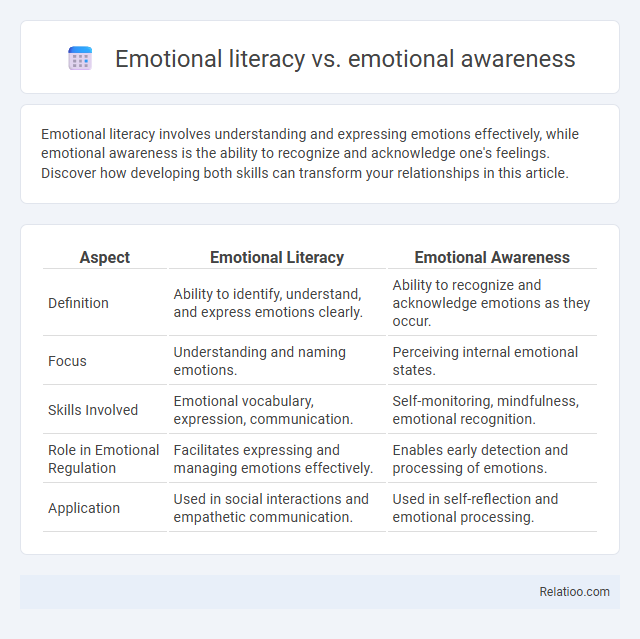Emotional literacy involves understanding and expressing emotions effectively, while emotional awareness is the ability to recognize and acknowledge one's feelings. Discover how developing both skills can transform your relationships in this article.
Table of Comparison
| Aspect | Emotional Literacy | Emotional Awareness |
|---|---|---|
| Definition | Ability to identify, understand, and express emotions clearly. | Ability to recognize and acknowledge emotions as they occur. |
| Focus | Understanding and naming emotions. | Perceiving internal emotional states. |
| Skills Involved | Emotional vocabulary, expression, communication. | Self-monitoring, mindfulness, emotional recognition. |
| Role in Emotional Regulation | Facilitates expressing and managing emotions effectively. | Enables early detection and processing of emotions. |
| Application | Used in social interactions and empathetic communication. | Used in self-reflection and emotional processing. |
Understanding Emotional Literacy
Emotional literacy involves recognizing, understanding, and expressing your emotions clearly, forming the foundation for effective emotional awareness and regulation. Emotional awareness refers to the ability to identify and interpret your emotions and those of others, enhancing empathy and social interactions. Mastering emotional literacy empowers you to navigate complex emotional landscapes, improving communication and fostering psychological resilience.
Defining Emotional Awareness
Emotional awareness involves recognizing and understanding your own emotions as well as those of others, forming the foundation for effective emotional literacy. Emotional literacy builds on this by enabling you to express and manage emotions appropriately in various social contexts. Distinguishing these concepts is crucial for developing interpersonal skills and enhancing emotional intelligence.
Key Differences Between Emotional Literacy and Awareness
Emotional literacy involves recognizing, understanding, and expressing emotions effectively, while emotional awareness primarily refers to the ability to identify and notice emotions within oneself and others. Key differences between emotional literacy and emotional awareness include emotional literacy's emphasis on communication and management of emotions versus emotional awareness's focus on perception and acknowledgment. Developing emotional literacy requires practical skills in emotional regulation and interpersonal expression, whereas emotional awareness serves as the foundational recognition needed before deeper emotional processing occurs.
The Components of Emotional Literacy
Emotional literacy encompasses the ability to recognize, understand, express, and manage emotions effectively, incorporating components such as emotional awareness, emotional vocabulary, empathy, and emotional regulation. Emotional awareness, a key element of emotional literacy, involves identifying and understanding one's own emotions and recognizing emotions in others, which enhances interpersonal communication and self-awareness. Developing emotional literacy requires mastering these components, fostering emotional intelligence that supports mental health, relationship building, and social interactions.
The Role of Emotional Awareness in Daily Life
Emotional awareness is the foundational ability to recognize and understand one's own emotions and those of others, which enhances emotional literacy by enabling accurate expression and regulation of feelings. Emotional literacy builds on this awareness, encompassing the skill to communicate emotions effectively and empathetically in social interactions. In daily life, emotional awareness plays a critical role in improving decision-making, fostering healthy relationships, and managing stress by promoting self-reflection and emotional intelligence.
Benefits of Developing Emotional Literacy
Developing emotional literacy enhances your ability to accurately identify, understand, and express emotions, leading to improved interpersonal relationships and mental health. Emotional awareness allows you to recognize emotions as they arise, while emotional literacy takes this a step further by equipping you with the skills to manage and communicate these feelings effectively. Cultivating emotional literacy supports empathy, conflict resolution, and resilience, empowering you to navigate social situations with greater confidence and emotional intelligence.
Enhancing Emotional Awareness Skills
Enhancing emotional awareness skills involves recognizing and understanding one's own emotions and those of others, which differs from emotional literacy that emphasizes effectively expressing and managing these feelings. Emotional awareness serves as the foundational step toward emotional literacy, fostering empathy, self-regulation, and improved interpersonal communication. Developing emotional awareness through mindfulness practices and reflective exercises strengthens emotional intelligence and supports better mental health outcomes.
Emotional Literacy in Education and the Workplace
Emotional literacy encompasses the ability to recognize, understand, express, and manage emotions effectively, forming a foundational skill crucial in both education and the workplace. Unlike emotional awareness, which involves simply noticing emotions, emotional literacy drives deeper emotional intelligence by enabling you to navigate social interactions and resolve conflicts constructively. Developing emotional literacy in your educational environment and professional setting enhances communication, fosters empathy, and improves teamwork, leading to more supportive and productive relationships.
Common Misconceptions About Emotional Literacy and Awareness
Emotional literacy and emotional awareness are often confused, but emotional literacy encompasses not only recognizing emotions (emotional awareness) but also understanding, expressing, and managing them effectively. A common misconception is that emotional literacy simply means being aware of emotions, whereas it involves a broader skill set including emotional vocabulary and regulation strategies. Many people underestimate the role of emotional literacy in improving interpersonal relationships and mental health, assuming it is innate rather than a learnable competency.
Choosing the Right Approach for Personal Growth
Emotional literacy involves the ability to recognize, understand, and express emotions effectively, while emotional awareness specifically refers to the conscious attention to your feelings in the moment. Emotional intelligence integrates these skills with empathy and social interaction, enabling effective relationship management and decision-making. Choosing the right approach for personal growth requires assessing whether you need foundational skills in emotional literacy or more nuanced emotional awareness to enhance your overall emotional intelligence and interpersonal success.

Infographic: Emotional literacy vs Emotional awareness
 relatioo.com
relatioo.com